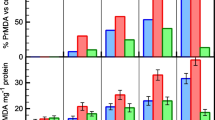Abstract
Cirrhosis represents the terminal stage of a number of chronic liver diseases. Consequences include accumulation of toxic metabolic wastes, reduced synthesis of key proteins, increased portal venous pressure, and portosystemic shunting. We conducted a case-control study to assess the serum levels of S100B protein and parameters of oxidative stress, superoxide dismutase (SOD), catalase (CAT) and oxidative stress measured by the thiobarbituric acid method (TBARS), in a group of 14 pediatric patients with cirrhosis. No differences were found between groups in S100B protein levels. SOD activity and TBARS levels were higher; and CAT activity was lower in the cirrhotic group. A negative correlation between S100B and TBARS in the case group was found (r = −0.815, p = 0.001). Conclusions: This study didn’t indicate a possible role of S100B serum levels as marker of brain damage in cirrhotic children but suggest a possible relation between astrocyte function and oxidative damage in cirrhotic children.

Similar content being viewed by others
References
Bernard O (1997) [Cirrhosis in children]. La Revue du Praticien 47(5):519–523
Hazell AS, Butterworth RF (1999) Hepatic encephalopathy: an update of pathophysiologic mechanisms. Proc Soc Exp Biol Med 222(2):99–112
Gutteridge JM, Halliwell B (2000) Free radicals and antioxidants in the year 2000. A historical look to the future. Ann N Y Acad Sci 899:136–147
Mahadik SP, Evans D, Lal H (2001) Oxidative stress and role of antioxidant and omega-3 essential fatty acid supplementation in schizophrenia. Prog neuropsychopharmacol Biol psychiatry 25(3):463–493
Poli G (1993) Liver damage due to free radicals. Br Med Bull 49(3):604–620
Comporti M (1985) Lipid peroxidation and cellular damage in toxic liver injury. Lab Invest; J Technic Meth Pathol 53(6):599–623
Dalgic B, Sonmez N, Biberoglu G et al (2005) Evaluation of oxidant stress in Wilson’s disease and non-Wilsonian chronic liver disease in childhood. Turk J Gastroenterol 16(1):7–11
Poli G, Albano E, Dianzani MU (1987) The role of lipid peroxidation in liver damage. Chem Phys Lipids 45(2–4):117–142
Bianchi G, Marchesini G, Fabbri A et al (1997) Lipoperoxide plasma levels in patients with liver cirrhosis. Hepatogastroenterology 44(15):784–788
Mansouri A, Gaou I, Fromenty B et al (1997) Premature oxidative aging of hepatic mitochondrial DNA in Wilson’s disease. Gastroenterology 113(2):599–605
Sokol RJ, Twedt D, McKim JM et al (1994) Oxidant injury to hepatic mitochondria in patients with Wilson’s disease and Bedlington terriers with copper toxicosis. Gastroenterology 107(6):1788–1798
Herrmann M, Vos P, Wunderlich MT et al (2000) Release of glial tissue-specific proteins after acute stroke: A comparative analysis of serum concentrations of protein S-100B and glial fibrillary acidic protein. Stroke; J Cereb Circ 31(11):2670–2677
Lara DR, Gama CS, Belmonte-de-Abreu P et al (2001) Increased serum S100B protein in schizophrenia: a study in medication-free patients. J Psychiatr Res 35(1):11–14
Schmidt AP, Tort AB, Amaral OB et al (2004) Serum S100B in pregnancy-related hypertensive disorders: a case-control study. Clin Chem 50(2):435–438
Walz R, Portela LV, Tort AB et al (2000) Serum S100B levels in patients with HTLV-I-associated myelopathy/tropical spastic paraparesis. Neurology 54(10):2021–2022
Donato R (1999) Functional roles of S100 proteins, calcium-binding proteins of the EF-hand type. Biochim Biophys Acta 1450(3):191–231
Wiesner RH, McDiarmid SV, Kamath PS et al (2001) MELD and PELD: application of survival models to liver allocation. Liver Transpl 7(7):567–580
Portela LV, Tort AB, Schaf DV et al (2002) The serum S100B concentration is age dependent. Clin Chem 48:950–952
Bannister JV, Calabrese L (1987) Assays for superoxide dismutase. Methods Biochem Anal 32:279–312
Aebi H (1984) Catalase in vitro. Methods enzymol 105:121–126
Wills ED (1966) Mechanisms of lipid peroxide formation in animal tissues. Biochem J 99(3):667–676
Costa LG, Manzo L (1995) Biochemical markers of neurotoxicity: research strategies and epidemiological applications. Toxicol Lett 77(1–3):137–144
Conde de la Rosa L, Schoemaker MH, Vrenken TE et al (2006) Superoxide anions and hydrogen peroxide induce hepatocyte death by different mechanisms: involvement of JNK and ERK MAP kinases. J Hepatol 44(5):918–929
Szuster-Ciesielska A, Daniluk J, Kandefer-Szerszen M (2002) Oxidative stress in the blood of patients with alcohol-related liver cirrhosis. Med Sci Monit 8(6):CR419–CR424
Han D, Hanawa N, Saberi B et al (2006) Hydrogen peroxide and redox modulation sensitize primary mouse hepatocytes to TNF-induced apoptosis. Free Radic Biol Med 41(4):627–639
Nishikawa T, Lee IS, Shiraishi N et al (1997) Identification of S100b protein as copper-binding protein and its suppression of copper-induced cell damage. J Biol Chem 272(37):23037–23041
Acknowledgments
The authors thank CAPES and FIPE for financial support.
Author information
Authors and Affiliations
Corresponding author
Rights and permissions
About this article
Cite this article
Ribeiro, L., Andreazza, A.C., Salvador, M. et al. Oxidative Stress and S100B Protein in Cirrhotic Children . Neurochem Res 32, 1600–1603 (2007). https://doi.org/10.1007/s11064-007-9365-2
Received:
Accepted:
Published:
Issue Date:
DOI: https://doi.org/10.1007/s11064-007-9365-2




